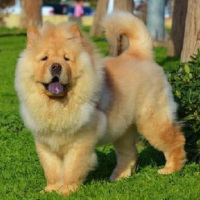Appearance of the Chusky
|
| A powerful dog with a broad body and deep chest, the Chusky's stance and conformation testify to strength and independence. Many describe them as a less lean Husky with altered markings. Their muzzle is larger than a Husky's and often less long. Their ears are erect and triangular, larger than those of their Chow Chow relative. Their almond-shaped eyes are bright and alert, and can be blue, green or brown. Wall eyes, where one is blue and the other brown, are not uncommon. Their well-muscled bodies are supported by stocky, sturdy limbs. Their plush tails are of medium length and can curl over the back (as with the Chow Chow) or hang down (as with the Siberian Husky). Weighing between 18 and 30 kg and measuring between 45 and 68 cm, the Chusky tends to be a robust medium to large-sized dog. The Chusky's dense coat protects it well in winter, but can lead to overheating in the warmer months. The double layer offers protection from the elements while being soft to the touch. White, red, gold and crinkled coats have all been reported, and some puppies retain the darker, eyebrow-shaped markings of their Siberian Husky parent. |
Temperament of the Chusky
|
| Predicting the personality of a newly-developed mixed breed can be a challenge because, although puppies could be expected to inherit a good mix of traits from each parent, some will behave more like a breed apart. As Chusky dogs evolve over time, we'll have a better idea of their overall personality, but for now we can make an educated guess based on what we know of their ancestors, and then we can look to the breed members that already exist. Chusky dogs tend to be incredibly loyal to their families and have a strong desire to protect them and their property. Their dedication makes them superb watchdogs and they are always on the alert, guaranteeing their family's safety. Likewise, they can be trained to be excellent watchdogs and have no fear of intruders. Chow Chows have a reputation for being resolute and stubborn, a characteristic that many Chuskys seem to have inherited. Many also desire to be dominant and can constantly challenge and question authority. Combine this with the potential to be high-strung and high energy, and it quickly becomes apparent that this is not a breed for the timid. Inexperienced owners should consider another breed, as the Chusky can be undeniably difficult to handle. |
Needs and activities of the Chusky
|
| These are high-energy dogs, as they come from very active parent breeds. Due to their lineage, it is recommended that these dogs have a large enclosed yard to play in. They should be walked at least 3 times a day and have free play time with other dogs. Activity needs can be met by running, off-leash park visits and dog play groups to increase socialization and expend energy. He can enjoy agility classes and flyball competitions, and of course, obedience training should always be part of his week. The Chusky is not recommended for apartment living; he needs a big house, an active family and plenty of mental and physical stimulation to be happy. |
Maintenance of the Chusky
|
| The Chusky is a very hairy dog. You may find yourself constantly vacuuming behind him. He'll need daily brushing with a brush, and in periods of heavy shedding, the use of a detangling tool will be very useful to remove any clumps of fur. Some owners of this hybrid cut the hair during the summer months to avoid the heat stress that could result from such a dense coat. Teeth brushing several times a week, nail trimming every two months and ear cleaning to check for dirt and moisture should be carried out weekly. Start the routine when your Chusky is young and grooming won't be troublesome at all. |









 English (United Kingdom)
English (United Kingdom)